 W
WThe "cursed soldiers" or "indomitable soldiers" is a term applied to a variety of anti-Soviet and anti-communist Polish resistance movements formed in the later stages of World War II and its aftermath by members of the Polish Underground State. This all-encompassing term for a widely heterogeneous movement was introduced in early 1990s.
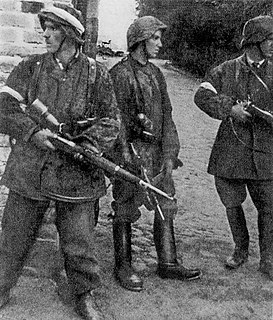 W
WThe Tatra Confederation, or Confederation of the Tatra Mountains, was a Polish resistance organization operating in the southernmost Podhale region during the Nazi German occupation of Poland. The Tatra Confederation was founded in May 1941 in Nowy Targ – the historical capital of Podhale, by the poet and partisan, Augustyn Suski ; with Tadeusz Popek as his deputy. The organization had its ideological roots in the peasant movement of the mountain region of interwar Poland.
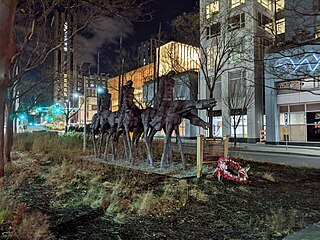 W
WThe Partisans is a 1979 aluminum sculpture by the Polish-American sculptor Andrzej Pitynski that has been exhibited in Boston, Massachusetts, since 1983. The sculpture depicts Polish anti-communist "cursed soldiers". It is dedicated to freedom fighters worldwide.
 W
WJadwiga Apostoł-Staniszewska was a Polish teacher in the interwar period, an underground activist during World War II, and a writer in postwar Poland.
 W
WJózef Batory was a Polish soldier and resistance fighter during World War II and after.
 W
WStefan Bembiński ) was a Polish veteran of World War II, member of the Home Army, and a Polish senator.
 W
WMarian Bernaciak was a lieutenant in the Polish Army, a member of ZWZ and the Home Army, a major and a legendary leader of an underground partisan unit of WiN in the Lublin region.
 W
WCaptain Franciszek Błażej was born on 27 October 1907 in Nosówka, in Austrian Galicia. He was a professional officer of the Polish Army and participated in the Polish September Campaign. Some time in the early 1940s, he joined the Rzeszów division of the Union for Armed Struggle.
 W
WJanusz Bokszczanin was a colonel of the Polish Army and one of the first Polish commanders of the motorized troops in the reborn Second Polish Republic. During World War II he joined the ZWZ resistance organization and later the Home Army. Until 1943 he served as chief of department of rapid response within its headquarters. In 1944, prior to the anti-Fascist Operation Tempest, he became the chief of operations, and deputy chief of staff of the entire Home Army (AK).
 W
WZdzisław Broński - was a reserve officer of the Polish Army, member of ZWZ and the Home Army, one of the partisan leaders of the anti-communist underground Freedom and Independence, WiN, in the Lublin region.
 W
WKarol Chmiel (1911–1951) was born on 17 April 1911 in the village of Zagorzyce to the peasant family of Antoni and Katarzyna née Charchut. He graduated from high school in Dębica, and was admitted to the prestigious Jagiellonian University in Kraków, where he studied law. After graduation, in 1935, Chmiel settled in Wojslaw, a village near Mielec; his wife Irena Suchodolska was a school principal, and he worked for the Town Hall in Mielec.
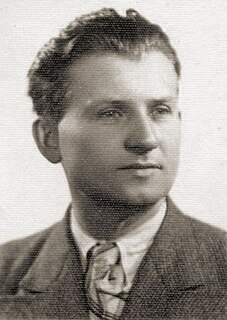 W
WŁukasz Ciepliński [Polish pronunciation: [ˈwukaʂ t͡ɕɛˈpliɲskʲi]] was a Polish soldier who fought in the Polish anti-Nazi and anti-communist resistance movements. He used various aliases: Pług, Ostrowski, Ludwik, Grzmot, and Bogdan. Ciepliński was executed at Mokotów Prison in Warsaw, with a shot to the back of the head by the Polish secret police, Urząd Bezpieczeństwa.
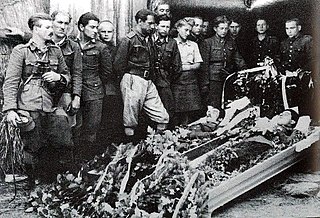 W
WHieronim Dekutowski was a Polish boy scout and soldier, who fought in Polish September Campaign, was a member of the elite forces Cichociemni, fought in the Home Army and after World War II, fought the communist regime as one of commanders of Wolność i Niezawisłość.
 W
WHenryk Antoni Flame was a corporal and pilot in the Polish Air Force, and a captain of the anti-Nazi, and anti-Communist resistance organization NSZ.
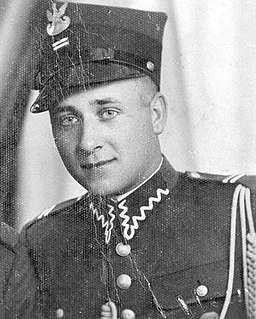 W
WJózef Franczak was a soldier of the Polish Army, Armia Krajowa World War II resistance, and last of the cursed soldiers – members of the militant anti-communist resistance in Poland. He used codenames Lalek, Laluś, Laleczka, Guściowa, and fake name Józef Babiński. He was a resistance fighter for 24 out of 45 years of his life.
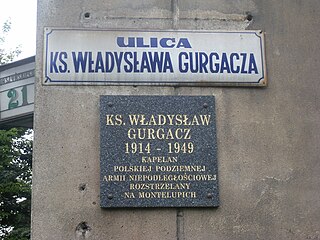 W
WWładysław Gurgacz was a Polish Catholic priest, member of the Society of Jesus, and chaplain of the anti-communist underground.
 W
WAntoni Heda was a Polish military commander and a notable veteran of the Polish resistance movement in World War II and later independence movement against Soviet occupation following the war. Among the best known of his partisan actions was the raid on Communist prison in Kielce in August 1945, in which roughly 300 political prisoners were freed. His codename was "Szary" (Grey).
 W
WMajor Franciszek Jerzy Jaskulski, aka 'Zagończyk', was a soldier in the Polish Home Army and a commander in Freedom and Independence in the Radom region of Poland. In 2007 the Polish president Lech Kaczyński posthumously awarded Jaskulski the order of Polonia Restituta.
 W
WKazimierz Kamieński was an officer of the Polish Army, commander in the underground Polish Home Army (AK), ROAK and the anti-communist organization Freedom and Independence (WiN). He was one of the longest fighting soldiers of the Polish anti-Communist resistance after World War II.
 W
WStanisław Józef Bronisław Kasznica was the last commander of the National Armed Forces (NSZ), an anti-communist, and anti-Nazi paramilitary organization, which was part of the Polish resistance movement in World War II and in the period following it.
 W
WMieczysław Kawalec, born in 1916 in the village of Trzciana, Rzeszów County, was a Polish resistance fighter. In the late 1930s, he graduated from the Law Department at Lwów University, and took the job of an assistant there. During the Polish September Campaign, he fought in the defence of Lwów, and in 1940 he joined the Rzeszów District of Union of Armed Struggle (ZWZ).
 W
WMarek Kubliński was a Polish Boy Scout and a Cracow high-school student whose fame rests on his activities as an anticommunist freedom fighter.
 W
WJózef Kuraś,, noms-de-guerre "Orzeł" (Eagle) and from June 1943 "Ogień" (Fire); was born in Waksmund near Nowy Targ. He served as lieutenant in the Polish Army during the invasion of Poland, and became the underground member of Armia Krajowa and Bataliony Chłopskie in the Podhale region. Soon after the end of World War II, he was one of the leaders of the so called "cursed soldiers".
 W
WMajor Adam Lazarowicz was a Polish military officer who played a prominent role in the Polish resistance movement in the German-occupied Poland in the Second World War.
 W
WWładysław Łukasiuk was a captain of the Polish Army, of the Home Army (AK), and the anti-communist underground.
 W
WJan Mazurkiewicz, pseudonym: "Zagłoba", "Socha", "Sęp", "Radosław" was a Polish military leader and politician, colonel of Home Army and brigadier general of the Polish People's Army. Founder of the Secret Military Organization, commander of Kedyw and the Radosław Group during Warsaw Uprising. After the war, he was a political prisoner of the Stalinist period. From 1964 he was vice-president of Society of Fighters for Freedom and Democracy.
 W
WFranciszek Niepokólczycki alias Teodor, Szubert, Franek, Żejmian, Halny was a colonel of Polish Army. During World War II, commander of the Union of Retaliation, officer of the Union of Armed Struggle and the Kedyw of Home Army. President of the Freedom and Independence from 1945 to 1946 and political prisoner of the Stalinist period.
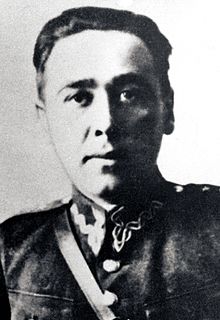 W
WAntoni Olechnowicz (1905–1951) was a Polish military officer. A Lieutenant Colonel of the Polish Army, he took part in the September Campaign. Arrested by the Soviets, he escaped and returned to his native Vilna, where he soon joined the Polish underground: the Service for Poland's Victory, the Union of Armed Struggle and finally the Home Army. He took part in the Operation Ostra Brama as commanding officer of the East group attacking the city of Vilna from the direction of Nowa Wilejka and Belmont.
 W
WWitold Pilecki was a Polish cavalry officer, intelligence agent, and resistance leader. Early in World War II he co-founded the Secret Polish Army resistance movement.
 W
WFranciszek Przysiężniak - was a lieutenant in the Polish Army, an officer of anti-communist resistance groups National Military Organization (NOW) and National Military Union (NZW).
 W
WRomuald Rajs, nom de guerre "Bury", was a Polish soldier and anti-communist insurgent. Rajs was a member of Home Army (AK) and National Military Union (NZW). In 1946 the unit under his command burned several Belarusian villages in the region of Białystok and massacred about 79 villagers. He was sentenced to death in a show trial held by the Polish communist government in 1949, charged with membership in delegalized NZW. Following the trial, he was executed in 1949. His death penalty was nullified by the Military Court of Warsaw in 1995. Rajs is revered by regional nationalist Polish groups as a hero which creates tensions with the local Belarusian and Eastern Orthodox inhabitants.
 W
WJan Rzepecki alias „Prezes” was a Polish soldier and military historian, colonel of the Polish Army. Commander of the Bureau of Information and Propaganda of Home Army from 1940 to 1945. After World War II commander of the Armed Forces Delegation for Poland and the first president of the Freedom and Independence.
 W
WCaptain Józef Rzepka was born in 1913 in the village of Bratkowice in Austrian Galicia. He graduated from the 1st High School in Rzeszów, then went to Warsaw to study law at Warsaw University.
 W
WDanuta Helena Siedzikówna was a Polish medical orderly in the 4th Squadron of the 5th Wilno Brigade in Home Army. In 1946 she served with the Brigade's 1st Squadron in Poland's Pomerania region. Considered a national heroine, she was captured, tortured and sentenced to death at the age of 17 by the communist authorities.
 W
WZygmunt Szendzielarz was the commander of the Polish 5th Wilno Brigade of the Home Army, nom de guerre "Łupaszka". He fought against the Red Army after the end of the Second World War. During the Red Army occupation he was falsely accused of crimes, in order to slander the cursed soldiers and consolidating the rule of the communists. After the fall of communism, in 1993, Szendzielarz was rehabilitated and declared innocent of all charges.[1] On 2007 Polish president Lech Kaczyński posthumously awarded Szendzielarz with the order of Polonia Restituta.[6] He was executed in the notorious Mokotów Prison as one of the anti-communist so-called Cursed soldiers following the Soviet takeover of Poland at the end of World War II.
 W
WEdward Wasilewski, pseudonym Wichura, was one of the best known anti-communist fighters in the Polish resistance during the Soviet takeover of Poland. Under his command, 44 underground soldiers successfully attacked the NKVD camp in Rembertów on the night of 20–21 May 1945, and liberated 700–1000 NKWD prisoners. Wasilewski was arrested on 26 March 1946 and, after a year spent in prison, was broken by agents of the Ministry of Public Security. He worked as an informant until 1960, denouncing many of his former colleagues. He committed suicide by jumping out of a window in 1968, on the day of the Warsaw Pact invasion of Czechoslovakia.
 W
WSecond lieutenant Jerzy Zakulski was an attorney in interwar Poland, and World War II member of the National Armed Forces in German-occupied Poland. He was sentenced to death and executed by Stalinist officials in Soviet-controlled postwar Poland, on trumped-up charges of being an enemy spy.
 W
W